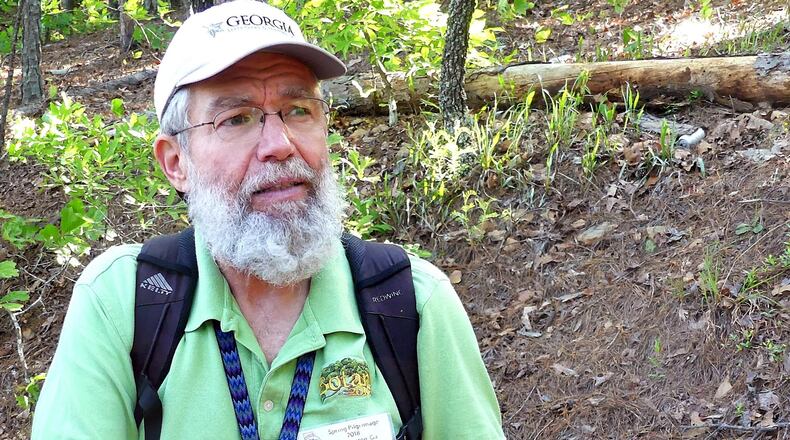To most folks I presume, lichens are merely those crusty patches and splotches found on rocks, trees, tombstones, bare soil, old wooden fences and other outdoor surfaces. They appear nearly everywhere — in the yard on dead azalea limbs or all over Stone Mountain, covering the granite monolith with a green patina.
But if you examine lichens under a magnifying hand lens, or loupe, a tiny, fascinating world opens up — microscopic landscapes of mountains, valleys, meadows and canyons, bathed in vibrant colors and textures. The fruiting bodies of some lichens may resemble tiny, pixie-like plates, cups and saucers. The common lichens known as British soldiers are so-named for the bright red color of their fruiting bodies.
This enchanting world was introduced to us Georgia Botanical Society members last weekend by Malcolm Hodges, a leading lichen expert. We were in the Sprewell Bluff Wildlife Management Area in Meriwether County on one of several field trips offered during the society’s annual Wildflower Pilgrimage, which was headquartered this year in Thomaston.
One hardwood tree, Hodges noted, may harbor more than 30 different lichen species of all shapes and colors, with some preferring to live on the lower trunk and others favoring branches near the top.
But the most fascinating thing about lichens, Hodges said, is that each is made up of two components: a fungus and an alga. The algae contain chlorophyll and make the food through photosynthesis; the fungi furnish water, minerals and shade.
In these symbiotic relationships, lichens live, function and reproduce as single organisms. Thus, they are given proper Latin names as if they were individual species.
Hodges and several fellow lichen experts are now involved in the Georgia Lichens Project to document, describe and map lichen species all over the state. So far, they have identified 1,065 species in 132 Georgia counties.
IN THE SKY: The moon will be new on Tuesday. Mercury is low in the east just before dawn and will appear near the moon Monday morning.
Venus is in the west at dusk and sets about 2 hours later; it will appear near the moon Thursday night. Mars and Saturn rise in the east at around midnight. Jupiter is in the east at dusk.
About the Author
Keep Reading
The Latest
Featured


